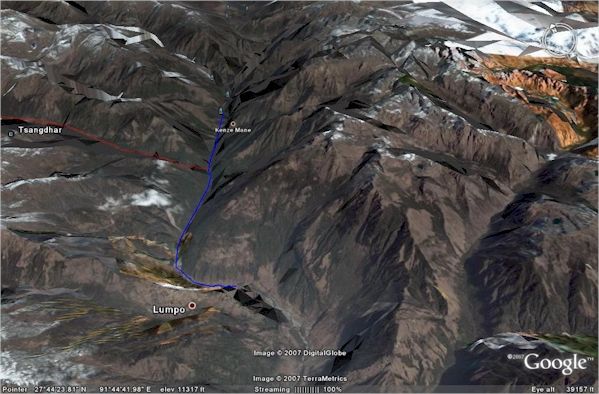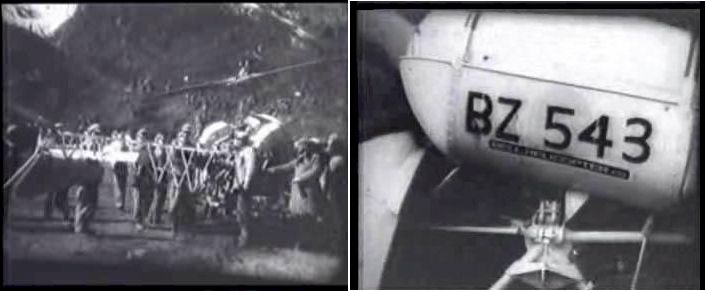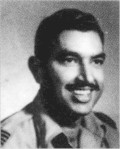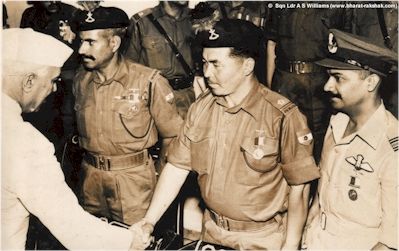These incidents occurred at the northeast border between India and Tibet. In October 1962, during the border war between India and China, I was in charge of Rescue & Relief Operations in that part of India, commanding 105 Helicopter Unit.
A Night Rescue (11 Oct 1962)
It was during the days of 1962 Indo-China Border Dispute that the following casualty evacuation was carried out. Over a few days I had been busy from dawn to dusk evacuating casualties almost non-stop. On 11 Oct 1962 it was late in the evening that an urgent message was received from the Tsangdhar outpost situated on the border with Tibet (China) that a critically sick jawan (Sep. Suram Chand) was in urgent need of medical attention which could not be provided by the medicos at the outpost and that he would not survive the night if left there.
The sun was about to set. The Bell 47G-3 helicopter which was used to fly missions was not fitted for night flying. In other words there were no landing lights, no cockpit lights and no instrument lights either. Late in the evening it was foolhardy to undertake this rescue mission.
But the call was urgent. How could one ignore it? After all it was the big brass at Air Headquarters that had allowed me to be excused from combatant duties as a bomber pilot when I embraced the Baha’i Faith (which teaches that the Earth is but one country and mankind its citizens that work performed in a spirit of service is worship) and transferred me to Rescue & Relief role on helicopters. So how could I not be faithful to the trust placed by the Government?
So I requested that a signal be sent to the outpost to keep the patient close to the improvised helipad of the outpost, to save on the boarding time on landing. After that I hastened to the helicopter dressed in flying overalls. The ground staff had already kept the helicopter ready. The starter trolley was in position. And without wasting a second the engine was started and it was airborne. The route through the valleys and across ridges was well known though not well marked on the million-inch aviation maps!
By the time the outpost was reached, the sun had set. I waited at the helipad, the engine idling and the rotor halted. The jawans were happy to see the helicopter but there was no patient within sight. The jawans said the patient was on his way. It was a long wait. The evening was getting darker and darker with every passing minute. To my dismay there was no sign of the moon or the patient.
The patient was evidently in a very critical state which was causing this extraordinary delay. At last after what appeared to be an eternity I saw the stretcher party winding its way carrying flares and torches to show the rocky path. It was bitterly cold, the patient was wrapped up in many folds of blankets. He was gently placed and safely harnessed to the seat.
The medico, when he saw the totally dark cockpit and instrument panel, offered me a torch which I gratefully accepted. Now there was a fresh dilemma. If I aimed the torch light at the slim instrument panel in front, between the patient and me, the bright light of the beam would destroy night vision. It was now pitch dark. Only the dark silhouette of the western mountain ranges were visible. People who know the mountains will know the speed with which darkness descends in the valleys after sunset. It was imperative that I preserve night vision. And it was equally imperative that I see the Main Rotor RPM Gauge to maintain rotor rpm within the very narrow specified limits at all times during flight. This then was the dilemma.
| The Bell G-47 was one of the first helicopters in the IAF. This example (BZ-542) belonged to No.104 Squadron. |
All Bell 47G helicopter pilots know that both hands are occupied with flying; the left on the collective lever and the right on the cyclic control with both feet on the rudder pedals. To solve this I had to enlist the willing cooperation of the very sick and fragile patient. I placed the torch within the folds of his blanket in such a way that a subdued and narrow beam of light from the well-wrapped-up torch would fall only on the RPM Gauge of the Main Rotor, on the instrument panel. I placed his hand on the wrapped-up torch and requested him to hold it steady till we land. So, with the patient’s help and a prayer we plunged into the darkness of the night.
The aircraft was not certified for IFR flight or night flying. I had to strain the eyes to find any references in the darkened landscape to maintain a safe flying attitude. I kept safety height plus some more feet to cater for the uncertainties and continued flying in the dark for several minutes. I knew there was a Dropping Zone (DZ) about midway to the Base Camp. This DZ (Lumpu) was on a ridge at a much lower level. Unknown to me and to some great relief I found a ring of flares way down below me. This I immediately knew was on the DZ. The local Army Detachment Commander had used his initiative and had hurriedly improvised a landing place for the rescue helicopter. They had spread the canopy of a supply dropping parachute and secured it on the edges. Several oil soaked flares around this canopy were lit as soon as they had heard the distant sound of rotor beating in the darkness. A few jawans with lit torches were standing around the white canopy, waving their torches to attract attention and pointing the beams on the white canopy. I got the message loud and clear. I forthwith descended from the safety height plus 500 ft. and spiralled down to a happy landing.
This Army Detachment had an advanced medical base with qualified doctors to attend to the patient. I was very thankful to the patient for keeping the subdued light on the instrument panel and to the CO of the Army Detachment for improvising the night landing facility on his own and within such a short time. Without them the rescue mission would certainly have been another statistic on the list of fatalities during this Border War. The next day I returned to Zimithang.
 |
| The Thag-La Ridge Sector – a bird’s eye view from 40,000 feet looking NNE. The Red line north of Tsangdhar was the Namka Chu River, where the Indian troops of 7 Brigade were eye to eye with the Chinese troops north of the river. Thag La ridge runs north of the river. The Namka Chu joined the Nyamjang Chu (Blue line). The Author flew frequent sorties to Tsangdhar from Zimithang (not seen here but at lower center of the picture where the copyright notices appear. The distance between Zimithang – Tsangdhar was around 8-9 miles as the crow flies. |
Rescue Mission to Tsangdhar (20 Oct 1962)
I was called upon to rescue the casualties as and when they occurred. These parts of the Himalayas are very high and the valleys are full of glaciers. The mountain ridges are sharp and craggy. The rescue had to be done by flying the rescue helicopter to a border outpost we called Tsangdhar which was in the area of conflict and located at an altitude of about 11,500 feet. It did not have a regular helipad. Instead we had to land on an improvised clearing in the midst of huge boulders and craggy rocks. Since the rescue helicopter (Bell 47-G3) could take only two stretcher cases at a time, at that altitude I had to make several trips each day flying the casualties down to an Advance Medical Base near the foothills. These rescue operations went on for several days. There was an urgent need for another rescue helicopter.
On 20 October 1962, I was called to Gauhati to air test another helicopter and bring it to this advanced base to join the rescue team. In the meantime, unknown to me, Sqn Ldr Vinod K Sehgal was flying in to Zimithang, in another rescue helicopter.
After the air test at Gauhati as soon as I took off for Zimithang I was promptly recalled by AVM (Tiger) Jaswant Singh. He greeted me on the tarmac and straight away took me to the nearest supply dropping Dakota which had just returned from a supply dropping mission over Tsangdhar. It was peppered with bullet holes. He then gave me specific orders not to fly to Tsangdhar outpost as it was already occupied by the Chinese.
On landing at the Army Advanced base, Zimithang, the local Army commander immediately ordered me to fly to Tsangdhar, as his signals officer and the recently arrived relief helicopter pilot, Sqn.Ldr. Vinod Sehgal, had that morning flown there to restore communication. He said I should go and find out what happened and report back. Of course I told him that the outpost had been captured by the Chinese, that I had specific orders not to go there. He refused to believe the first point, so I did not press the latter point too much as Vinod Sehgal was a very dear old friend.

| ABOVE: In this rare screen capture from a Chinese News Film, Sqn Ldr Vinod Sehgal’s helicopter is shown at the Tsangdhar Helipad in Chinese Hands. The close up shot shows the serial as BZ-543. Sqn Ldr Sehgal (right) was presumably killed after he made the landing. The Helicopter was not returned by the Chinese after the war. |  |
So I conveniently stuck to the theory that the latest command is most valid and I took off to investigate and find out what the problem was at the outpost. On reaching there I could not see the usual smoke signal (to indicate the wind direction). There was no sign of life at the outpost. It was all too strange and silent. So I flew around in a circle over the outpost looking for any sign of life or signal. I was flying inside the cirque formation of the mountains where the outpost was located at a height of about 12,000 feet surrounded by peaks 15,000 – 20,000ft. Suddenly I was attacked by an ear-splitting barrage of bullets spattering the helicopter from all sides. The valley which a moment ago was so still and quiet was suddenly resounding with the RAT-TAT-TAT of machine gun fire from all sides. The cockpit instruments were shattered. The oil pressure indicator, or what was left of it, showed “zero”. I was hit on the upper back. I instantly executed a “corkscrew manoeuvre” and dived out of the cirque. It was the Chinese who had taken the outpost overnight and they were waiting.
It was quite clear that the engine would seize at any moment. Below was all ice and bare rocks. A crash landing was imminent.
Since I was familiar with the route and the up-drafts and down-drafts I hugged the edge of the cliff where there was a good up-draft. Fortunately, the damaged engine continued to fire and lifted the helicopter over the last ridge before seizing up. I auto-rotated down the other side of the valley. This gave enough time to send out a “Mayday” message. I was lucky to find a tight spot in which to auto-rotate and force land the helicopter next to the roaring gorge among boulders in a little clearing with a young tree in the middle. Of course the helicopter was a complete write-off.
I was bleeding from the mouth so I carried out an examination of my personal injuries. The bullet that had hit me on the upper back had not punctured the lungs, so the bleeding was solely from a cut inside the mouth, so fortunately I had escaped with only minor injuries as the limbs were still intact and fully functional. Since I had carried out a lot of rescue missions down this particular valley it was possible to find my way back through the maze of rocky ravines, boulders, trees and creepers, back to base.
On the way to the base I met a patrol of soldiers and told them that the helicopter had crashed and that they should safeguard it. They were anxious to know how I was. I spread my hands and let them know that I was fine. It was late in the afternoon and the hike back to base may have taken 2 – 3 hours but I reached the base at dusk. The faithful helicopter was a Bell 47G-3, No.BZ541.
We were unable to determine what happened to our friends at the outpost. The Chinese refused to acknowledge anything about Sqn.Ldr. Vinod Kumar Sehgal.
| Squadron Leader Arnold Sochindronath Williams (Far Right) seen after the investiture ceremony – The Prime Minister Sri Jawahar Lal Nehru is seen wishing one of the Army recipients. |  |
Webmaster’s Note: Sqn Ldr A S Williams (Satto) was awarded the Vir Chakra for the missions flown on October 20th as well as the earlier casevac sortie.
Further Reading:
- No.105 HU, AF page on the official website.
- Official Indian Armed Forces History of the 1962 India-China War – Historical Division.